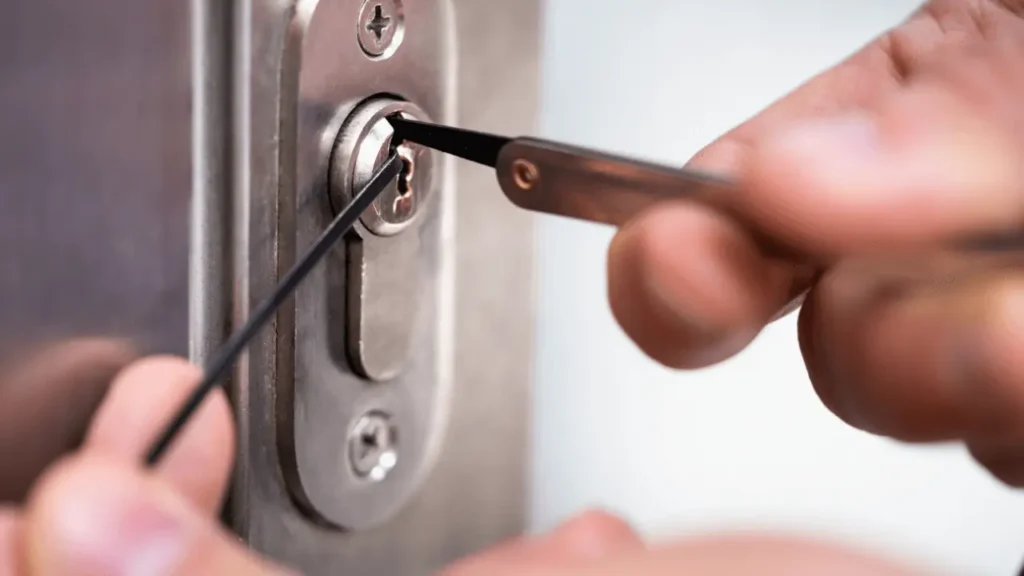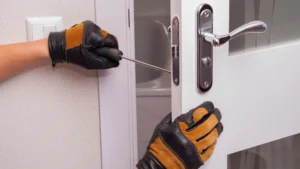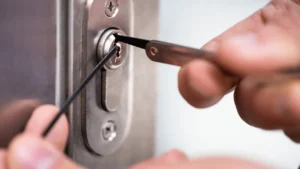5 Quick Fixes for Common Residential Lock Problems in Spanaway
- Call Us Today!
- 2067781068
Residents of Spanaway often face unexpected challenges with their door locks. Whether you are returning home late at night or simply need to secure your property, a malfunctioning lock can cause stress and inconvenience. In this article, we share five practical, easy-to-follow fixes for common residential lock problems. We focus on real user benefits and step-by-step problem solving so you can enjoy lasting peace of mind and improved home security.

Common Lock Issues in Spanaway Homes
Living in Spanaway comes with its unique blend of weather conditions and home styles. Many local residents notice that their door locks can become sticky, hard to turn, or may not latch properly.
Let’s break down some of the most common issues:
- Sticky Locks: Over time, dust and debris can build up inside the lock, making it harder to operate.
- Loose Screws: Daily use or weather-related wear can cause screws in the lock mechanism to loosen.
- Misaligned Strike Plate: A strike plate that is not perfectly aligned with the door latch can lead to problems with locking and unlocking.
- Worn Lock Cylinder: Frequent use can wear out the internal cylinder, reducing the overall effectiveness of the lock.
- Key Problems: Damaged or bent keys may not turn the lock smoothly and can lead to further damage.
Understanding these problems is the first step to making a quick and effective fix. By addressin
Fix #1: Lubricate Your Lock for Smooth Operation lubrication
Why Lubrication Matters
When your lock feels stiff or doesn’t turn easily, lubrication is often the first fix to try. Lubricants help reduce friction inside the lock mechanism, which makes turning the key much easier.
How to Lubricate Your Lock
- Gather Your Materials: You will need a lock lubricant, preferably a silicone-based spray. Avoid using heavy oils like WD-40 as they can attract dust and cause more issues over time.
- Clean the Lock: Use a dry cloth to remove any dust or debris from the outside of the lock.
- Apply the Lubricant: Spray a small amount into the keyhole. If your lock has a removable cover, take it off to spray directly inside.
- Test the Lock: Insert your key and turn it a few times to distribute the lubricant evenly.
User Benefits
- Improved Lock Performance: A well-lubricated lock is less likely to jam or stick.
- Extended Lock Life: Regular lubrication helps prevent wear and tear.
Cost-Effective: It is a low-cost solution that can delay the need for expensive repairs.
Fix #2: Tighten Loose Screws and Replace Worn Parts tighten
Recognizing Loose and Worn Components
Over time, the constant use of door locks can cause screws to become loose. In addition, some internal parts may wear out. Loose or worn parts can compromise the security of your home and may cause the door to not latch correctly.
Step-by-Step Guide to Tighten and Replace
- Inspect the Lock: Look for loose screws around the lock face and handle. If you notice any screws that move, it’s time to tighten them.
- Use the Right Tools: A small Phillips-head screwdriver is usually all you need.
- Tighten the Screws: Carefully tighten each screw. Do not overtighten, as this could strip the screws or damage the lock.
- Check for Worn Parts: If tightening does not solve the issue, check for any broken or worn parts. Replacement kits are available at local hardware stores.
- Follow the Manufacturer’s Instructions: When replacing parts, carefully follow the directions provided to ensure proper fit and function.
User Benefits
- Enhanced Security: Tightening screws ensures that the lock is firmly attached to the door, reducing the chance of break-ins.
- Improved Functionality: Replacing worn parts can bring your lock back to smooth operation.
- Peace of Mind: Knowing your door is secure reduces stress for you and your family.
Fix #3: Adjust the Strike Plate for Better Alignment strike
What Is a Strike Plate and Why It Matters
The strike plate is the metal plate that sits on the door frame. It has an opening where the latch fits in when the door is closed. If the strike plate is misaligned, your door might not close properly or the latch might not secure the door.
How to Adjust the Strike Plate
- Examine the Fit: Close your door and see if the latch aligns correctly with the strike plate. Notice any gaps or misalignment.
- Loosen the Screws: Using a screwdriver, loosen the screws on the strike plate just enough so that it can be adjusted.
- Adjust the Position: Move the strike plate slightly until the latch fits snugly into the opening.
- Tighten the Screws: Once you are satisfied with the alignment, tighten the screws securely.
- Test the Door: Open and close the door several times to ensure it locks and unlocks smoothly.
User Benefits
- Enhanced Locking Efficiency: A correctly aligned strike plate ensures that the lock catches properly every time.
- Increased Security: Proper alignment minimizes the risk of forced entry.
- User-Friendly: This adjustment is simple enough for most homeowners to do without professional help.
Fix #4: Repair or Replace the Lock Cylinder cylinder
Understanding the Lock Cylinder Problem
The lock cylinder is the heart of the lock mechanism. When it becomes worn or damaged, your key may not turn properly, leading to frustration and security risks.
Repairing the Lock Cylinder
- Clean the Cylinder: Sometimes, dirt and debris can cause the cylinder to stick. Use a can of compressed air to blow out any particles.
- Apply Lubricant: Just as with the overall lock, a light application of lubricant inside the cylinder can help it function better.
- Test the Key: Insert the key and check for smoother operation.
Replacing the Lock Cylinder
If cleaning and lubricating do not solve the problem, you may need to replace the cylinder:
- Purchase a Replacement: Visit a local hardware store in Spanaway to get the correct replacement cylinder.
- Follow Instructions Carefully: Removal and installation of the cylinder can be done using a simple set of tools. Follow the step-by-step instructions included with the new cylinder.
- Test the New Cylinder: After installation, check to make sure the key turns smoothly and the lock operates as expected.
User Benefits
- Reliable Security: A well-functioning lock cylinder is essential for keeping your home secure.
- Cost Savings: Repairing or replacing the cylinder on your own can save money compared to hiring a locksmith.
- Simple Maintenance: Regular upkeep of the lock cylinder can prolong the life of your lock.
Fix #5: Troubleshoot Key Problems and Re-key if Necessary troubleshoot
Identifying Key-Related Issues
Sometimes, the problem is not with the lock at all but with the key. A bent, worn, or poorly cut key can lead to difficulties when trying to unlock your door.
Steps to Fix Key Issues
- Inspect Your Key: Look for any signs of bending, wear, or damage. If the key looks abnormal, it might need to be replaced.
- Straighten a Bent Key: If the key is only slightly bent, you might be able to straighten it using a pair of pliers. Do this gently to avoid breaking the key.
- Get a New Key Cut: If the key is too worn out, visit a local hardware store or locksmith in Spanaway. Many places offer quick key cutting services.
- Re-key Your Lock: In some cases, it might be beneficial to re-key your lock entirely. This means replacing the internal pins of the lock so that a new key will work. This is a good option if you have lost keys or if the current ones are causing repeated problems.
User Benefits
- Smooth Operation: A new or properly fixed key can dramatically improve the ease with which you access your home.
- Increased Safety: Re-keying ensures that only the right key works with your lock, reducing the risk of unauthorized entry.
- Convenience: Local services in Spanaway often provide quick and affordable key replacements.
Tips for Preventing Future Lock Problems prevention
While fixing your lock problems is essential, taking steps to prevent them from occurring in the future is equally important. Here are some proactive tips:
Regular Maintenance
- Clean Your Locks: Periodically dust and clean your locks to remove any buildup that can cause sticking.
- Lubricate Regularly: Use a silicone-based lubricant on your locks every few months to keep them operating smoothly.
- Inspect Hardware: Every few months, check the screws, strike plate, and other components to ensure nothing is loose or damaged.
Smart Use Practices
- Avoid Force: Never force your key if it does not turn easily. Stop and investigate the cause of the problem.
- Be Gentle: When locking or unlocking your door, use a smooth, steady motion.
- Use Quality Keys: Invest in good-quality keys and keep spares in a secure place.
Security Upgrades
- Consider Modern Options: Upgrading to newer lock technology, such as digital locks, can sometimes reduce the number of mechanical issues.
- Regular Inspections: Consider scheduling a yearly inspection of your door locks with a local professional. This not only ensures security but can also prevent minor issues from becoming major problems.
Final Thoughts: Securing Your Home in Spanaway final-thoughts
For residents in Spanaway, keeping your home secure is a top priority. By following these five quick fixes -lubricating your lock, tightening loose screws and replacing worn parts, adjusting the strike plate, repairing or replacing the lock cylinder, and troubleshooting key issues -you can solve many of the common residential lock problems that occur over time.
Frequently Asked Questions (FAQ)
How do I fix a sticky front door lock in Spanaway?
A sticky door lock is often caused by dust or debris buildup. To fix it, clean your lock and apply a silicone-based lubricant to ensure smooth operation and prevent future issues.
What are the common causes of residential lock problems in Spanaway?
Common causes include dust accumulation, loose screws, misaligned strike plates, worn lock cylinders, and damaged keys. Local weather and frequent usage can also contribute to these issues.
Can I fix loose door lock screws myself in Spanaway?
Yes, you can fix loose screws using a small Phillips-head screwdriver. Simply inspect the lock, tighten any loose screws, and replace any worn parts to secure your door lock.
How do I adjust my door's strike plate for a better fit?
To adjust the strike plate, check that the latch aligns with the opening when the door is closed. Loosen the screws, reposition the plate for a snug fit, and then retighten the screws to secure it in place.
When should I consider repairing or replacing my lock cylinder in Spanaway?
If your key struggles to turn even after cleaning and lubrication, the lock cylinder may be worn out. In that case, it might be necessary to replace the cylinder to restore proper function and ensure security.
How do I troubleshoot key problems for my home lock?
Inspect your key for bends or wear. If it is damaged, try carefully straightening it or get a new copy cut. If problems persist, consider re-keying your lock to ensure smooth operation.
What preventive measures can I take to avoid lock issues in Spanaway?
Regular maintenance is key. Clean and lubricate your locks periodically, tighten loose screws, and inspect the strike plate and lock cylinder to catch issues early. These steps will help ensure your lock remains secure and functional.




